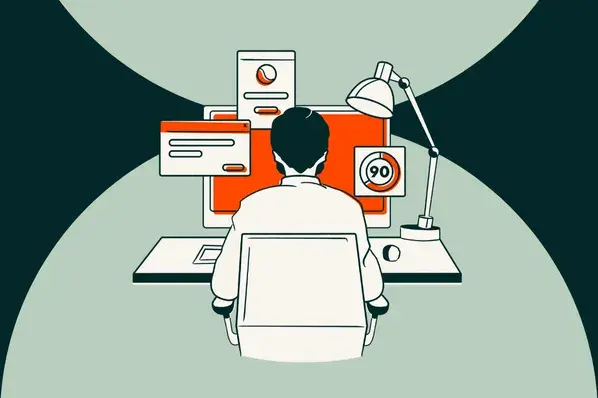In this post, I‘ve curated my picks for the six best subscription and membership website builders out there. Beyond sharing key details about these tools, I’ll also provide some real-life membership website examples to inspire you and give you some other useful information to help you create your own membership website.
Table of Contents
- How to Create a Membership Website
- What is a membership website?
- Membership vs. Subscription Websites
- What to Look for in a Membership or Subscription Website Builder
- Best Membership Website Platforms
- Membership Website Examples to Check Out
What is a membership website?
A membership website offers gated content and exclusive benefits to its members. These benefits can include special reports, newsletters, webinars, online courses, special invitations to conferences and events, free shipping, coaching, podcasts, and more.
Many businesses, nonprofits, clubs, and associations have membership websites to build an engaged and loyal audience.
Membership websites are often confused with subscription websites, but they offer different experiences. Let’s take a closer look at the key differences.
Membership vs. Subscription Websites
Membership and subscription websites are similar but not exactly the same.
A membership website allows customers to join a group, while a subscription site lets customers pay to use a product or service for a set period of time. I define a subscription website by its monthly or yearly financial contract, while a membership site may or may not require a paid subscription.
Most subscription websites are membership websites, but not all membership websites use the subscription model.
For example, you subscribe to Netflix by paying a monthly fee in exchange for unlimited access to the TV and movies on their site. It’s a fixed subscription fee, and you can cancel it anytime.
On the other hand, you can become a member — or a "Beauty Insider” — at Sephora. As a member, you get access to beauty classes, exclusive trial-size products and sets, and special promotions. You simply provide your contact information and use your unique login credentials to access your perks. You also get special added perks based on your spending.

To put up a gate for members or subscribers on your site, you can use a dedicated membership website software or a multi-purpose CMS with the required features and extensions.
Many of these platforms can also automate or simplify other tasks, like registering new subscribers or members, processing recurring payments, updating member profiles in one place, and delivering newsletters and other communications.
To learn more about subscription websites, check out our post on subscription business models.
Now, let’s learn how to create a membership website and reap the benefits.
How to Create a Membership Website
- Decide on your membership model.
- Create members-only content.
- Choose a membership platform or plugin.
- Publish your members-only pages.
- Promote your new membership offerings.
You have two main options for building your membership site — with basic website design platforms like WordPress or using a free membership website builder and CMS like Content Hub.
The benefit of building a site on an out-of-the-box platform is that the members’ area is usually integrated into your setup. With Content Hub, for example, you can easily gate content for members without needing to install an external plugin.
Once you have a website, you can offer memberships in five steps.
- Decide on your membership model.
- Create members-only content.
- Choose a membership platform or plugin.
- Publish your members-only pages.
- Promote your new membership offerings.
Below, I'll break down each of these steps.
1. Decide on your membership model.
Before even installing a platform or plugin, you have to create a membership model. To create your membership model, I first recommend answering these three crucial questions.
Question 1: What will you offer to your members?
First, brainstorm offerings for members. Evaluate your products, services, and messaging to decide on the value that you’ll bring to your customers. In this stage, it's helpful to examine your buyer personas and brainstorm what they’d enjoy having exclusive access to.
For example, a gym can offer access to its facilities, an educator offers access to courses, and a SaaS brand can offer access to a premium community of industry leaders.
Question 2: What membership levels will you offer, if any?
Next, decide on your levels of membership, if any. Depending on the level they join, members can get additional access to more content and more deals. Costco, for example, offers two levels — Executive Membership and Gold Star Membership.
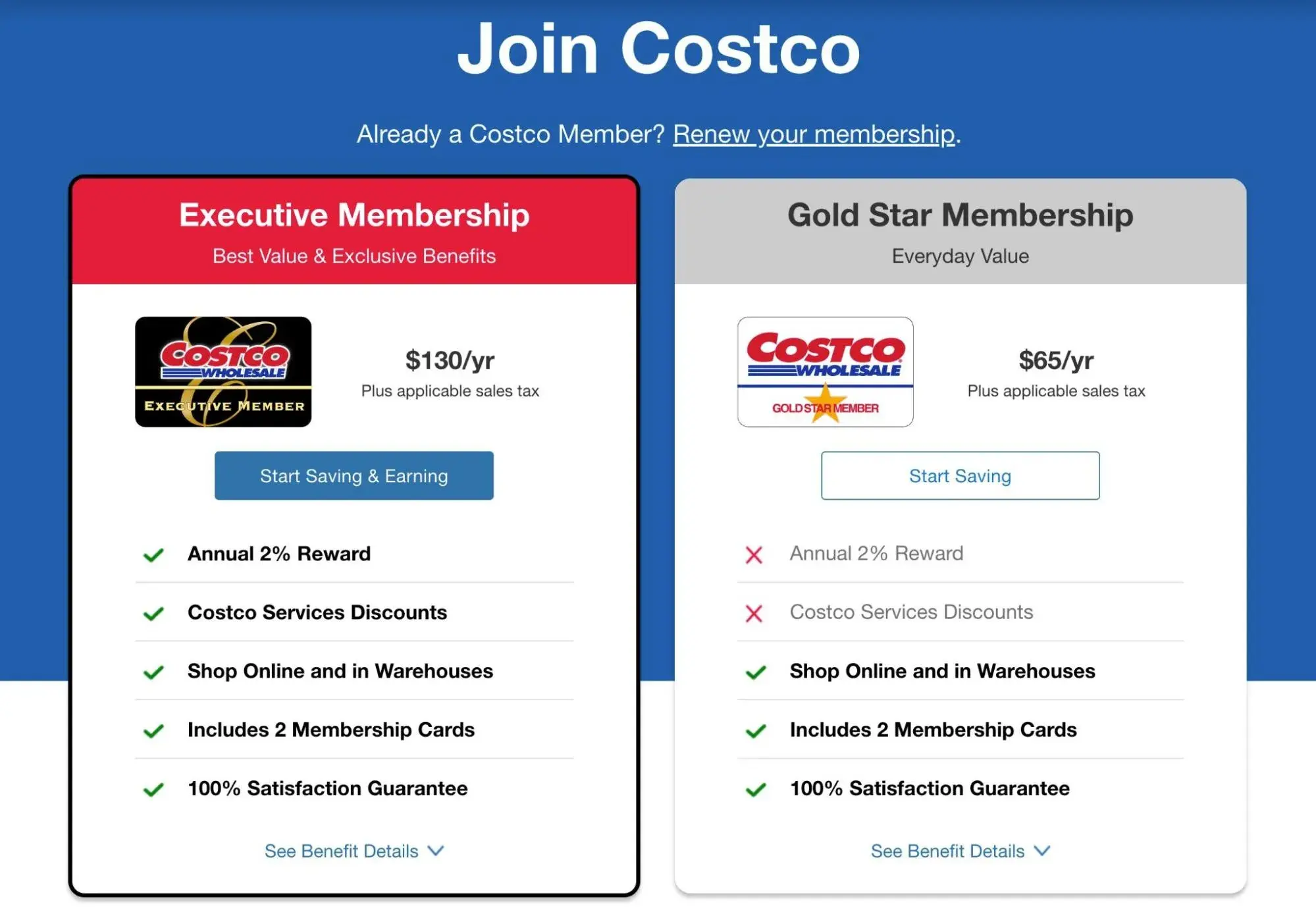
Alternatively, it might be worth starting with one uniform level that everyone can join. Amazon, Ulta, and Barnes & Noble have only one membership offering, making it simple to join.
Question 3: How much will you charge, if at all, and how frequently?
Last, decide on pricing, if any. Sometimes, it’s worth making membership free, as it can help you create a long list of marketing-qualified leads.
If you decide to charge, it’d be worth looking at your competitors' pricing. Decide the frequency — annual, biannual, and monthly are great options.
Membership Model Types
Once you’ve answered these three important questions, you can use these insights to choose your ideal membership model. Here are some of the popular options to consider:
- Freemium membership. This model offers free access to the product with some exclusive perks gated behind a paywall. Free members can upgrade to the paid membership to experience more benefits and get the best out of their membership.
- Tiered membership. This model delivers varying membership benefits based on different tiers. You can create two to four membership tiers to give people access to various perks related to your brand. Your audience can choose between these tiers based on their needs and budget.
- Content-based membership. This model offers access to exclusive content that members will value. You can curate stories, articles, videos, courses, and other content assets with member-only access.
- Offer-based membership. This model focuses on delivering your products or services at regular intervals. You can offer memberships for specific durations where members can avail of your offer at their convenience — like a subscription box delivering curated snacks or a car maintenance package with monthly servicing.
- Access-based membership. This model is ideal for physical spaces like gyms, co-working spaces, and other facilities. People can access specific areas or equipment only if they have membership access.
Once you’ve chosen your membership model, you can focus your attention on creating value for your members.
2. Create members-only content.
The next step is to create the gated content, pages, courses, events, and other assets you plan to offer to your members.
My formula for success is creating value-packed content before ever publishing your new membership site. This will help you delight your customers and keep them coming back for more.
Remember that perks-based membership models might not require the creation of gated content. However, creating exclusive resources may be just what entices users to join. Member-only emails are a great option. In these emails, you can hand out discount codes that only your members or subscribers have access to.
This step would also include creating a pricing page and a sign-up form. However, don’t publish any membership pages just yet. Before you do that, you have to choose a CMS or install a membership plugin. Let’s help you choose the right option.
3. Choose a membership platform or plugin.
If you’re on WordPress, you can compare membership plugins and choose the one that best meets your needs.
If you’re on another platform, I recommend first checking if that platform offers built-in membership functionality. If it doesn't, you can then investigate using a third-party membership solution, if possible.
Features to Look For
Regardless of the option you choose, a great membership plugin or platform will have the following features:
- Contact segmentation. Your chosen platform should allow you to segment your contacts into members and non-members and offer further segmentation capabilities if needed.
- Gated content. For any membership model to work, gating content is essential. It will differentiate your website visitors from your members. A membership platform should give you the option to selectively gate content based on membership status.
- User and member pages. Your platform should allow you to create membership-related pages and forms.
Here’s my list of some nice-to-have (but not mandatory) features:
- Automated workflows. Whether it’s used to send welcome or renewal emails, an automated workflow feature can help you save time.
- Payment provider integrations. You might not need this integration if you’re offering free membership. If you are, this is an important capability to look out for.
- Engagement analytics. This might not be required because you might be tracking engagement using another tool, such as Google Analytics. However, some membership platforms can give you even more granular data. Your Membership and Bold Memberships both offer this feature.
- Third-party integrations. You won’t need third-party integrations if you choose an out-of-the-box option such as Subhub or Content Hub. But if you’re using a plugin or an extension, it should integrate seamlessly with your other marketing tools. MemberPress, which is a WordPress plugin, integrates with Zapier so you can connect it to your other tools.
- Membership levels. If you’re offering different membership levels, you’ll need a plugin or platform that supports different levels and price points.
Knowing what you should look for should make it a little bit easier to make a choice.
4. Publish your members-only pages.
Remember the gated pages and posts that you created earlier? It’s time to publish those and mark them as members-only. For some platforms, you can do this with one click.
For others, you might have to navigate to the page you want to protect and select “members-only” from a drop-down menu.
In this step, you can also publish the pricing page. This should be public, as it will help users make a purchasing decision. If your membership platform doesn’t come with a pricing page option, or you don’t want to build a pricing table from scratch, consider installing a pricing table plugin.
You can create a community forum that’s accessible only to members.
5. Promote your new membership offerings.
Once all the legwork is complete, you have to spread the word about your membership.
I recommend you announce the all-new new membership to your social media followers, email contacts, and blog subscribers.
Before launching your membership, you can plan a multi-channel campaign to create some buzz and build excitement. Make the big reveal on the launch day to get as many people as possible.
To boost conversion rates and maximize participation, consider offering a limited-time reduced membership price. You can also follow Amazon’s example and offer reduced pricing for students. Another thing to consider is offering discounted fees to seniors and veterans.
What to Look for in a Membership or Subscription Website Builder
While I've already done a lot of work to curate a list of just the best subscription website builder tools, I know that it can still be a little difficult to choose just one for your membership site.
To help you further narrow down the list below and choose the right option, I recommend paying special attention to these details when evaluating a website builder for your membership site.
- Hosted SaaS vs. self-hosted software. Hosted SaaS tools are non-technical and easy to use but can cost more and not give you as much flexibility. Self-hosted open-source tools can be flexible and affordable but aren't as simple to use and require more maintenance.
- Supported content types. Make sure the platform supports the types of members-only content you want to offer, whether that's online courses, videos, newsletters, forums, coaching, podcasts, special discounts, and so on.
- Website builder functionality. Some tools are “website builders with membership functionality,” while others are “membership tools with website functionality.” The former will give you more flexibility for building your website but might not be as flexible for memberships, while the latter will give you lots of flexibility for memberships but might have more limited website-building functionality.
- Subscription flexibility. If you want to offer paid plans, look at the options you have for setting up subscription billing terms and pricing, as well as other things like free trials, one-time signup fees, prorated upgrades/downgrades, and so on.
- Frontend members area. In addition to analyzing the backend area where you'll manage your membership site, I also recommend checking out what the frontend member experience will be like for your subscribers. Beyond the general user experience, I also recommend seeing if members are able to manage their subscriptions from the frontend, as this will cut down on your admin work.
- Mobile app support. Some of these tools offer functionality to let you create your own branded mobile app. If you want subscribers to be able to engage on mobile devices, I think you should consider one of these options.
- Added transaction fees. Some website builders will charge transaction fees unless you pay for a more expensive plan. This should be an important consideration if you're looking to save money by using the cheapest plan.
Best Membership Website Platforms
- Content Hub
- MemberPress
- Wix
- Kajabi
- Squarespace
- Teachable
- EzyCourse
I’ve shortlisted the six best membership website builder platforms for creating a membership site.
Some of these are hosted SaaS tools, where launching a membership website is as simple as registering for an account. Others are self-hosted software that you can install on your own web hosting for ultimate control and flexibility.
I’ll cover both of these approaches so that you can pick the one that best meets your needs and goals.
1. Content Hub
Best for: Powerful marketing automation and content distribution.
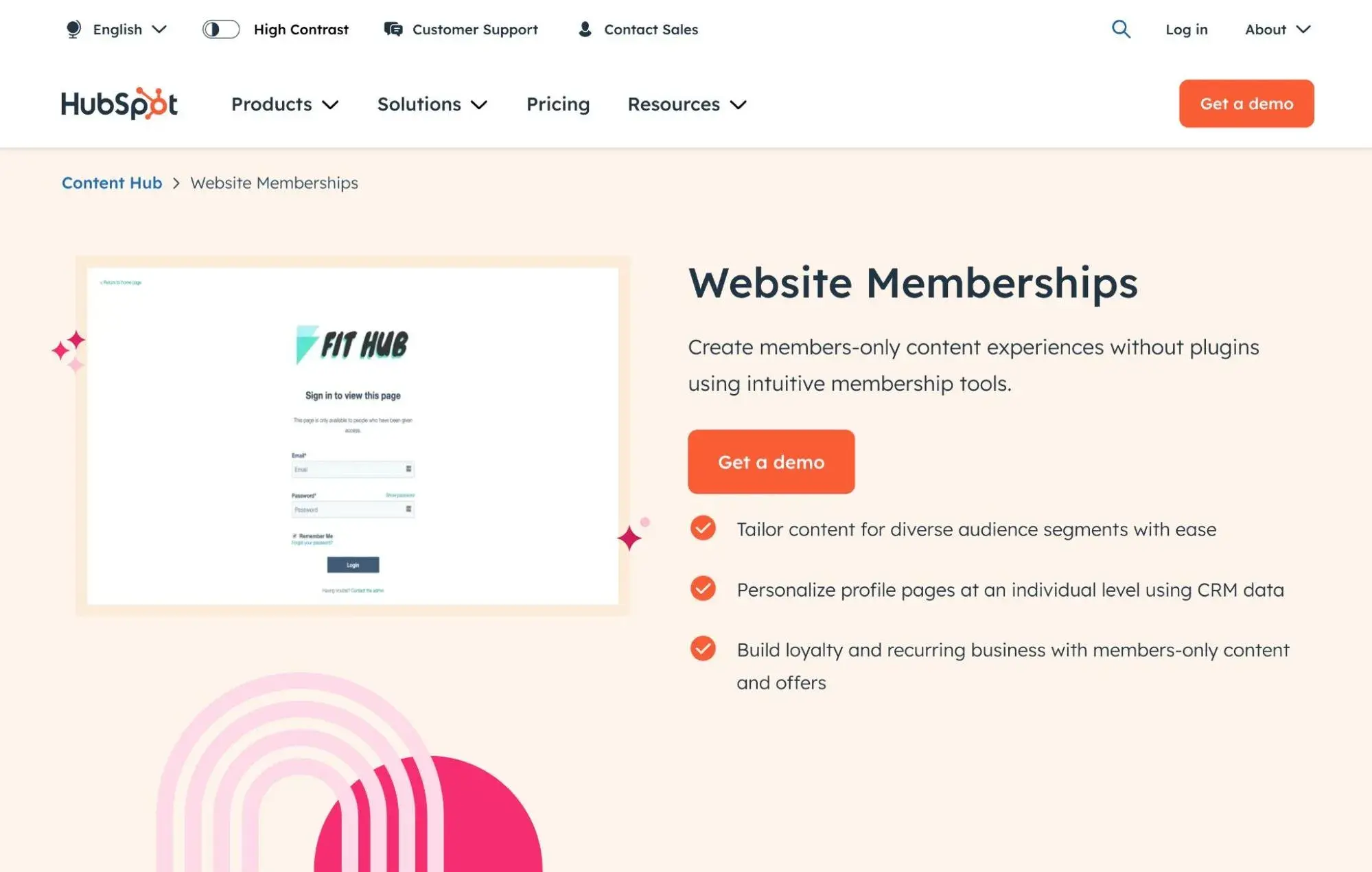
Pricing: Plans start at $450 per month for business and $15 a month for individual users.
Content Hub is a proprietary content management system that’s fully integrated with HubSpot’s marketing, sales, and service tools and CRM. With Content Hub, you can leverage HubSpot lists to allow only specific groups to access a section of your site.
HubSpot's many automation features also let you build completely personalized experiences for different users, which can help you more effectively engage your members.
You could create different experiences for entire segments of users or even personalize things at the individual user level. Based on my experience, this level of deep personalization isn‘t something that you’ll find in many other membership website builders.
With access levels, you can easily create as many membership levels as you need and then quickly apply them across your site. When combined with subscriptions, you could choose to only give customers access if they have a CRM tag indicating that they're a paid subscriber.
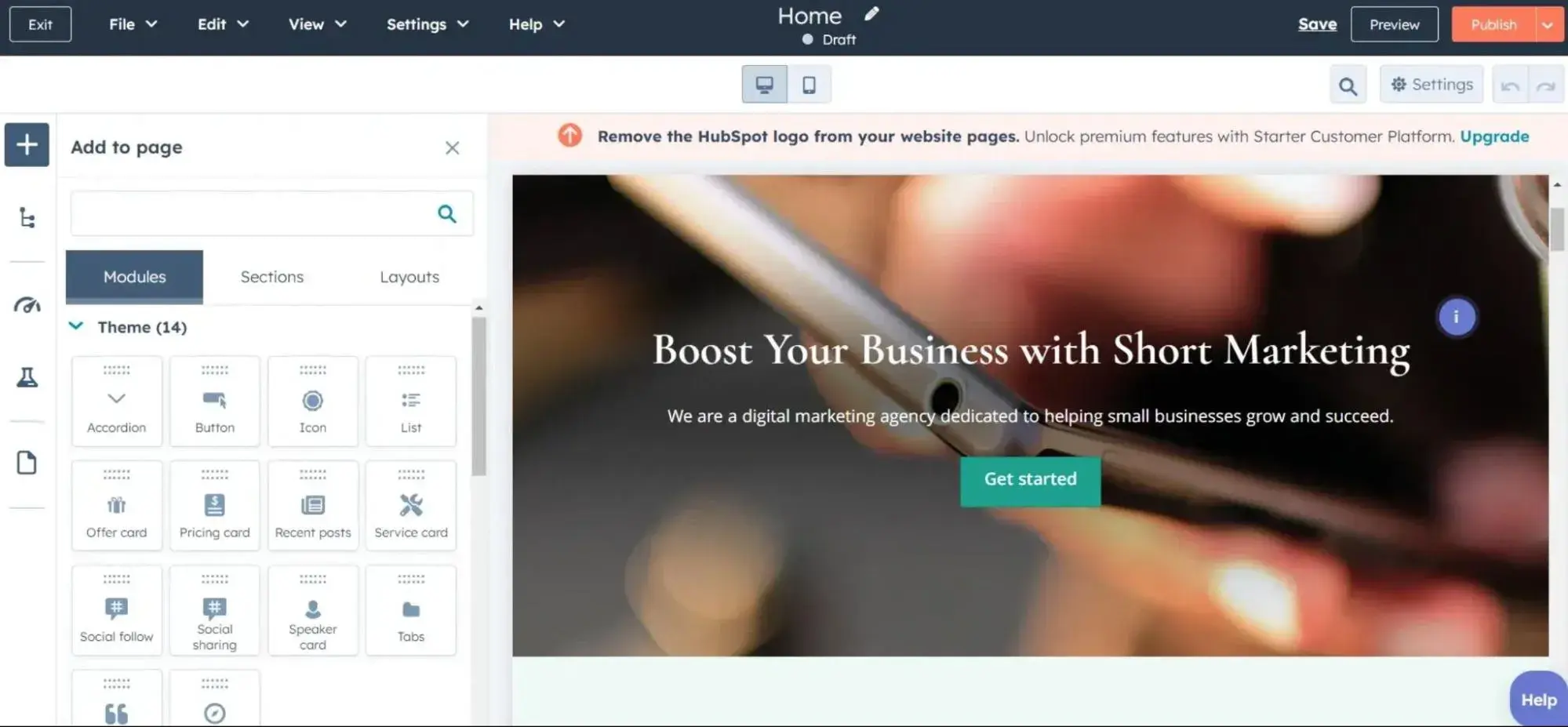
Get Started With HubSpot's CMS
Whether you're giving product updates to a current customer, pricing offers to prospects, or building web pages in different languages for a global audience, you can create all types of membership-based content with HubSpot.
Features:
- Drag-and-drop website builder with support for pre-made templates and AI website building.
- Built-in customer relationship manager (CRM).
- Unlimited membership levels.
- Restrict access to content using membership access levels.
- Personalize content for individual users.
- Support for transactional and marketing emails.
- Subscription management via the HubSpot Commerce Hub.
- Assign users to a specific membership level or dynamically adjust their levels based on their actions.
Pros:
- Built-in CRM. Having the HubSpot CRM integrated into your membership website gives you a ton of tools to implement more effective marketing, sales, and service strategies.
- Deep personalization functionalities. You can personalize your website for membership levels or even individual users, which isn‘t something that I’ve seen in a lot of other platforms.
- Easy website customization. You can easily customize your site using the visual builder, pre-made templates, AI tools, or even code (though you don't have to use code).
Cons:
- A few extra steps for paid subscriptions. HubSpot Content Hub doesn't offer built-in paid membership functionality, though you can set up recurring subscriptions with the HubSpot CRM. Instead, you would need to accomplish it using CRM tags or some other strategy.
What I love: Content Hub makes it super easy to create personalized experiences on your website, which lets you offer an optimized experience for each and every member. I also love how everything is integrated with the HubSpot CRM, as this lets you implement more effective marketing, sales, and customer service strategies for your membership website.
2. MemberPress
Best for: Self-hosted subscription websites powered by WordPress.
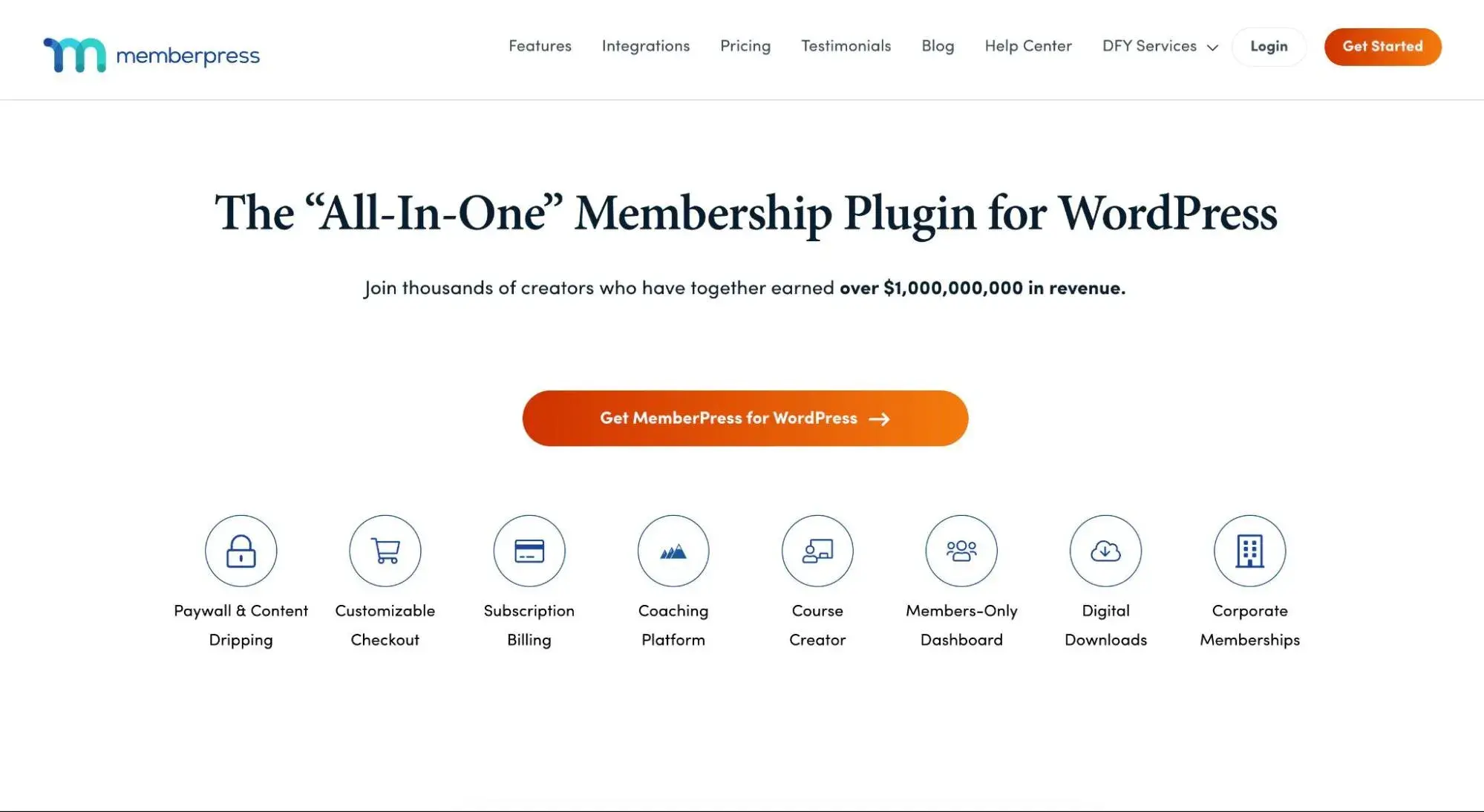
Pricing: Plans start at $359 per year, discounted to $179.50 for the first year.
You'll get started by setting up your WordPress site on your own hosting, including choosing a theme to control the design of your site. Then, you can install the MemberPress plugin to add all the essential membership subscription functionality.
You can create unlimited subscription tiers, each of which can have access to different content on your site. Setting up content restriction is easy and you can do it by restricting individual posts or creating your own bulk restriction rules. It also includes some unique options, such as the ability to create subscriber-only podcast episodes.
To process your subscriptions, you can choose from a variety of different payment gateways, including big names like Stripe and PayPal. MemberPress also gives you lots of flexibility for customizing your subscription terms, including offering free trials or one-time signup fees.
Features:
- Plugin for the open-source WordPress software.
- Unlimited membership levels.
- Fully customizable subscription periods, including support for free trials or one-time signup fees.
- Flexible content restriction, with support for different types of content.
- User-based content dripping to keep subscribers engaged.
- Support for most popular payment processors.
- Frontend members area so that subscribers can manage their own memberships.
Pros:
- Based on the WordPress software. This means you can also take advantage of all the other great features and plugins available for WordPress.
- Flexible content restriction. You get access to lots of options for controlling what content different membership tiers are able to access, which lets you customize your subscription website perfectly to your needs. You can also use content dripping to adjust the content restriction based on a schedule.
- Offer different types of member benefits. You can offer subscriber-only content, forums, products, podcast episodes, and so on. Basically, you can build pretty much any type of membership website.
- Marketing tool integrations. You can integrate MemberPress with most popular marketing tools, including the HubSpot CRM.
Cons:
- It’s based on WordPress software. While I personally find this to be an advantage, I think it‘s important to note that some people might not like this. I think this is especially true if you’re looking for more of a hands-off SaaS solution.
- Price jumps after the first year. The price doubles after the first year (starting at $359 from the original starting price of $179.50). It's still affordable for what you get, but I just want to make sure you plan for the full price.
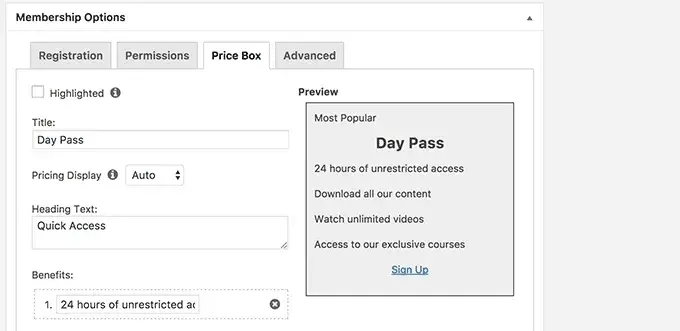
What I love: Because MemberPress is still based on WordPress, you get access to all of the incredible flexibility and ownership that come with the open-source WordPress software. At the same time, MemberPress still has a polished feature list and interface that compares favorably to SaaS subscription website builders.
3. Wix
Best for: A full-purpose website builder with membership functionality.
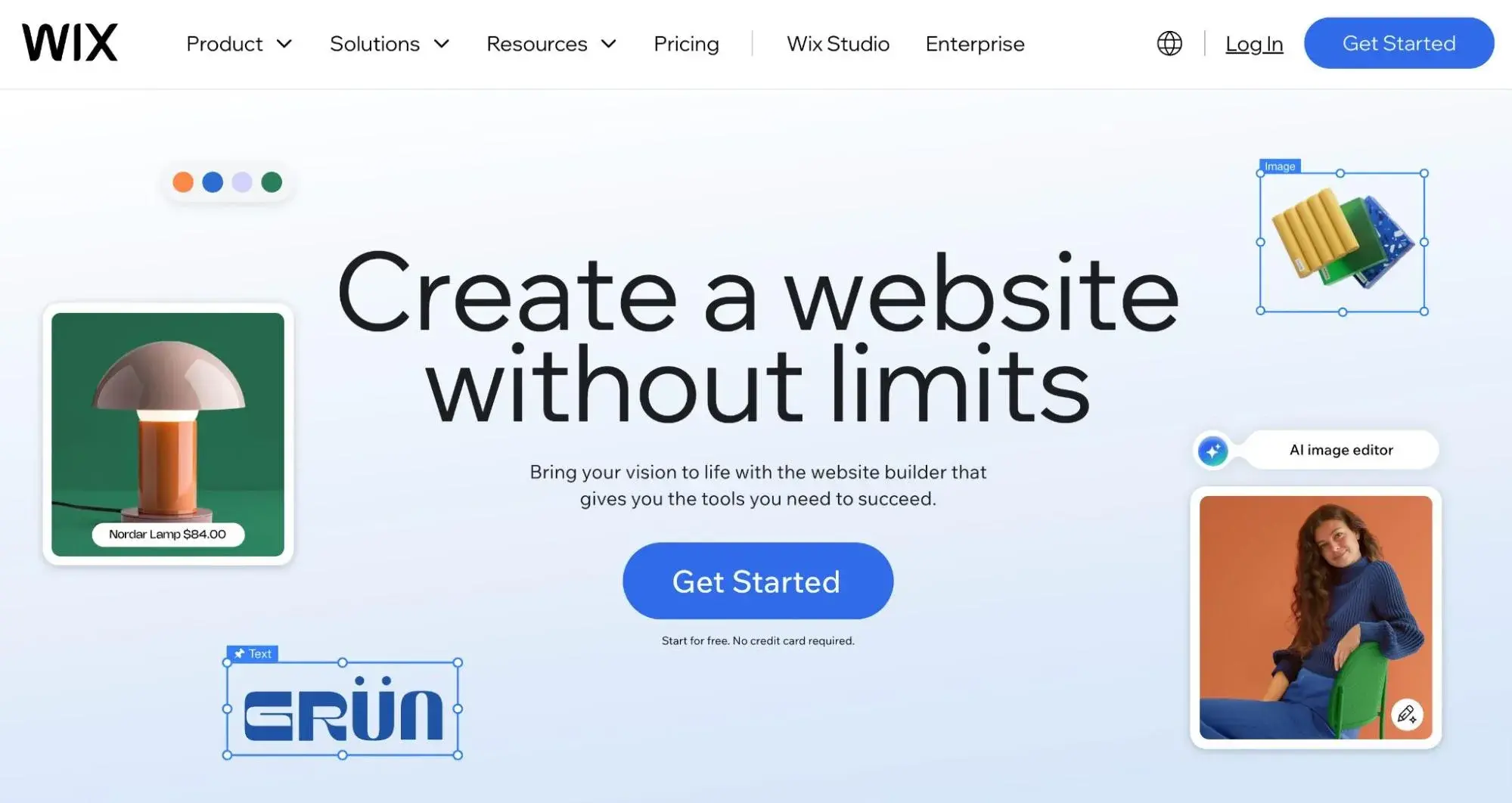
Pricing: Plans that support memberships start at $29 per month.
Wix is a full-service website builder tool that offers robust membership functionality.
I think this approach is great because it means you have a lot of flexibility for setting up your website, while still getting access to all the important membership functionality that you need.
While you can create a member’s area where visitors can register and access exclusive content even with the free/affordable plans, you'll need to upgrade to one of the higher-tier plans if you want to actually sell paid subscription access to your site. You can accept payments via the built-in Wix Payments tool or third-party processors like Stripe, PayPal, and Square.
In addition to creating memberships and restricting content, Wix also includes marketing tools, such as the ability to send emails to your members.
I also like that Wix offers an AI website builder in addition to its drag-and-drop editor, as this lets you quickly spin up your membership website using AI.
Features:
- Full-service SaaS website builder.
- Drag-and-drop design tool.
- AI website builder option, which lets you create your membership website design using AI.
- Robust membership functionality, including support for restricted content and online courses.
- Option to create multiple paid subscription levels.
- Process payments via a variety of payment gateways.
- Mobile app support, which lets you offer your members mobile app access to your site.
Pros:
- Full-service website builder. This means that you can go beyond just subscription/membership functionality on your website, which I think can be really helpful for a lot of membership websites.
- Affordable. For the features that it offers, Wix is pretty affordable. You can already create flexible subscription websites with the $29 per month Core plan.
- Mobile app support. Wix‘s built-in mobile app support is pretty unique. I think it can be a big advantage if you’re creating a membership website that people want to access on the go.
Cons:
- Limited multilingual functionality. Because of this, I don‘t think it’s the best option for multilingual subscription websites.
- Other limitations because of its SaaS approach. Because Wix is a hosted SaaS tool, you won't get as much access as you would with a tool like WordPress. This results in certain other limitations, such as the inability to customize certain transactional emails.
- Hard to migrate to another platform. Wix doesn't make it very easy to migrate your content to another platform, so there is some degree of “locked-in” if you use it.
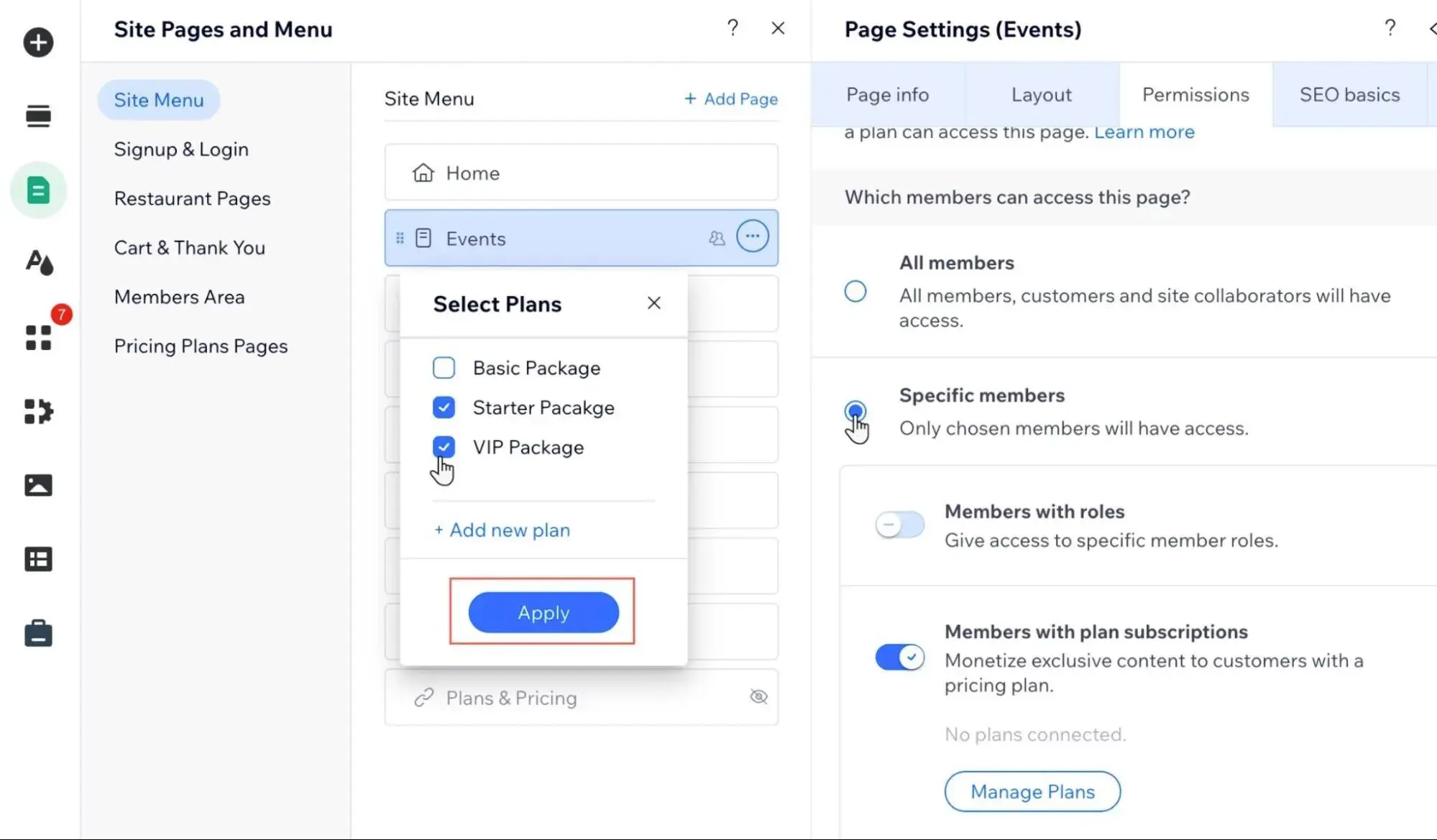
What I love: Wix can do a bit of everything well. While it's not the most powerful membership website builder on this list, it has all the features that most people will need while also giving you access to robust website building and lots of other helpful tools.
4. Kajabi
Best for: Offering a variety of different membership content types.
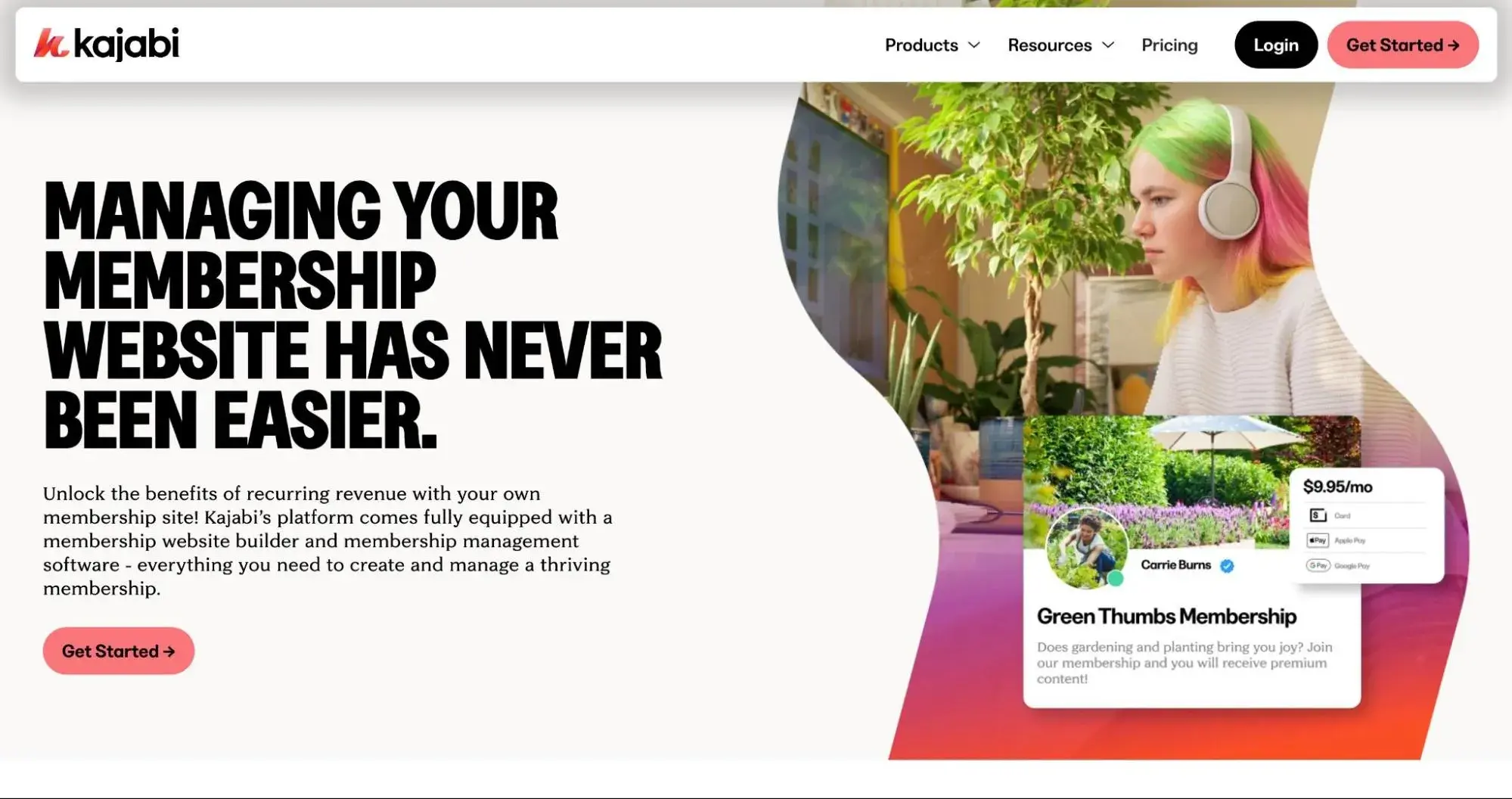
Pricing: Plans start at $69 per month.
Kajabi is a versatile membership website builder with a large selection of ready-made templates. It can handle a wide variety of membership community types, which I think is one of its big advantages.
You can use Kajabi for online courses, coaching, communities, newsletters, podcasts, and more. In my experience, this broad variety can be a great option for creators who want to experiment with different types of content to find what resonates the most with members.
You also get detailed reports to monitor your community’s progress and health with metrics like churn rate, monthly recurring revenue, and more.
In total, Kajabi creators have raked in over $8.8 billion, so you can definitely find membership success on this platform.
Features:
- Support for a variety of different membership offerings, including content, courses, coaching, communities, and more.
- Unlimited subscription tiers, including support for free trials and one-time setup fees.
- No added transaction fees on any plan.
- Built-in payment processing tools, including support for credit cards, PayPal, wallets, and more.
- Automatic sales tax calculations.
- Detailed reporting, including a special subscriptions dashboard.
- Built-in email marketing, including automations.
- Branded mobile app to give members access on their smartphones.
Pros:
- Support for a broad variety of content. I love how you can offer your subscribers a broad array of content as this lets you really get creative with what you offer.
- Built-in email marketing. Kajabi lets you send marketing emails to your subscribers without making you pay for a separate tool. This even includes automation and funnels.
- Mobile focus. I think that being able to offer your own branded mobile app can give you an advantage in an increasingly mobile-first world.
- No transaction fees on any plans. I‘ve noticed that many other SaaS website builders charge added transaction fees on their entry-level plans, so I think the fact that Kajabi doesn’t charge a transaction fee on any of its plans is a big advantage if you're looking for a SaaS tool.
Cons:
- Website builder isn't as flexible as dedicated builders. While Kajabi‘s website builder is totally fine for most use cases, I still don’t think it gives you as much flexibility as dedicated website builders like Wix, Squarespace and WordPress with MemberPress.
- Contact-based billing. While I don't think this will matter for all membership sites, this might make it expensive if you plan to have tens of thousands of members.
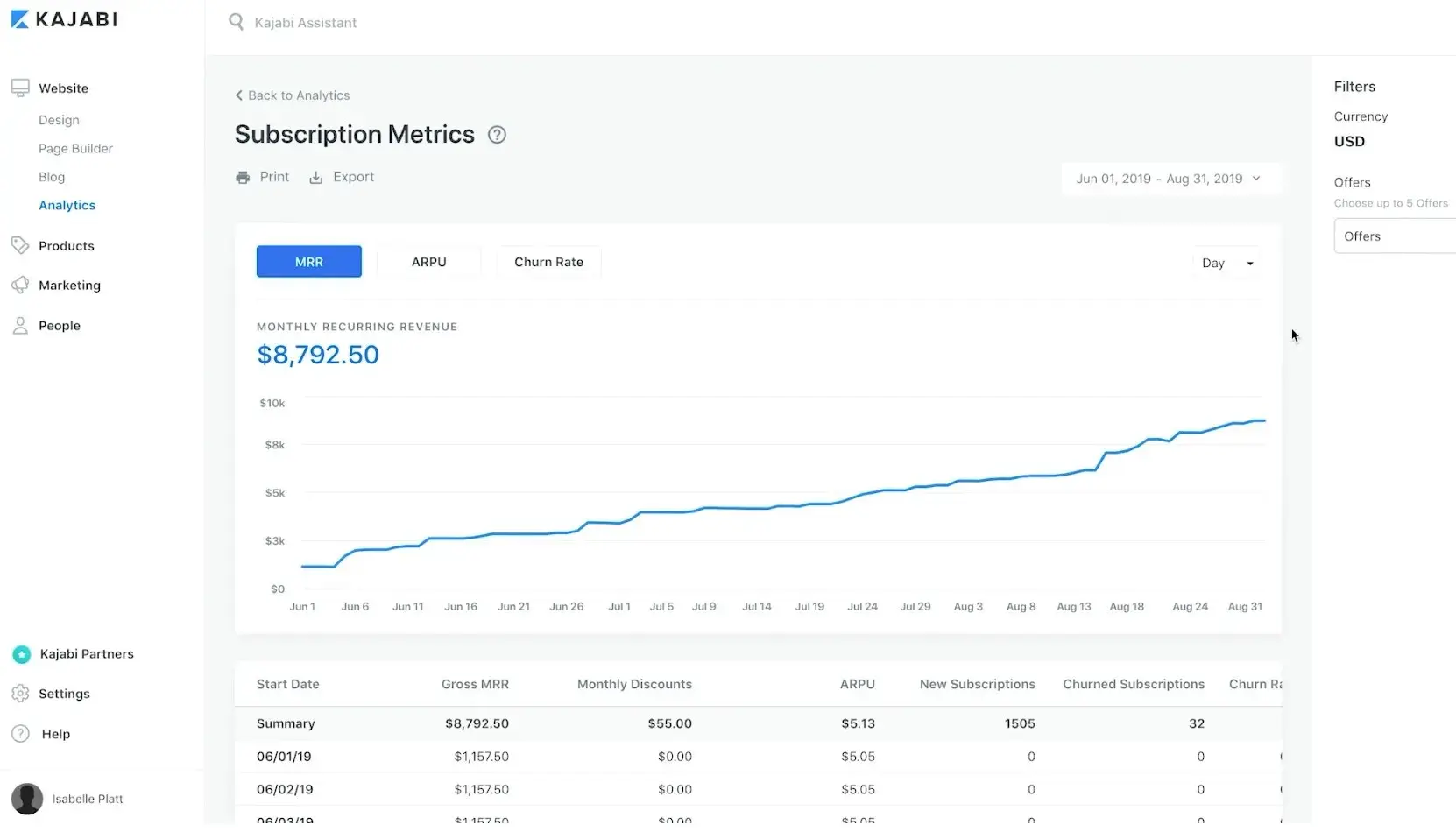
What I love: Kajabi‘s standout functionality is how it’s able to handle pretty much any type of content, from online courses to coaching, social communities, newsletters, podcasts, and more. You can attract subscribers with a variety of different offers and find what works best for your unique membership website.
5. Squarespace
Best for: Creatives looking for a hands-off membership site builder.
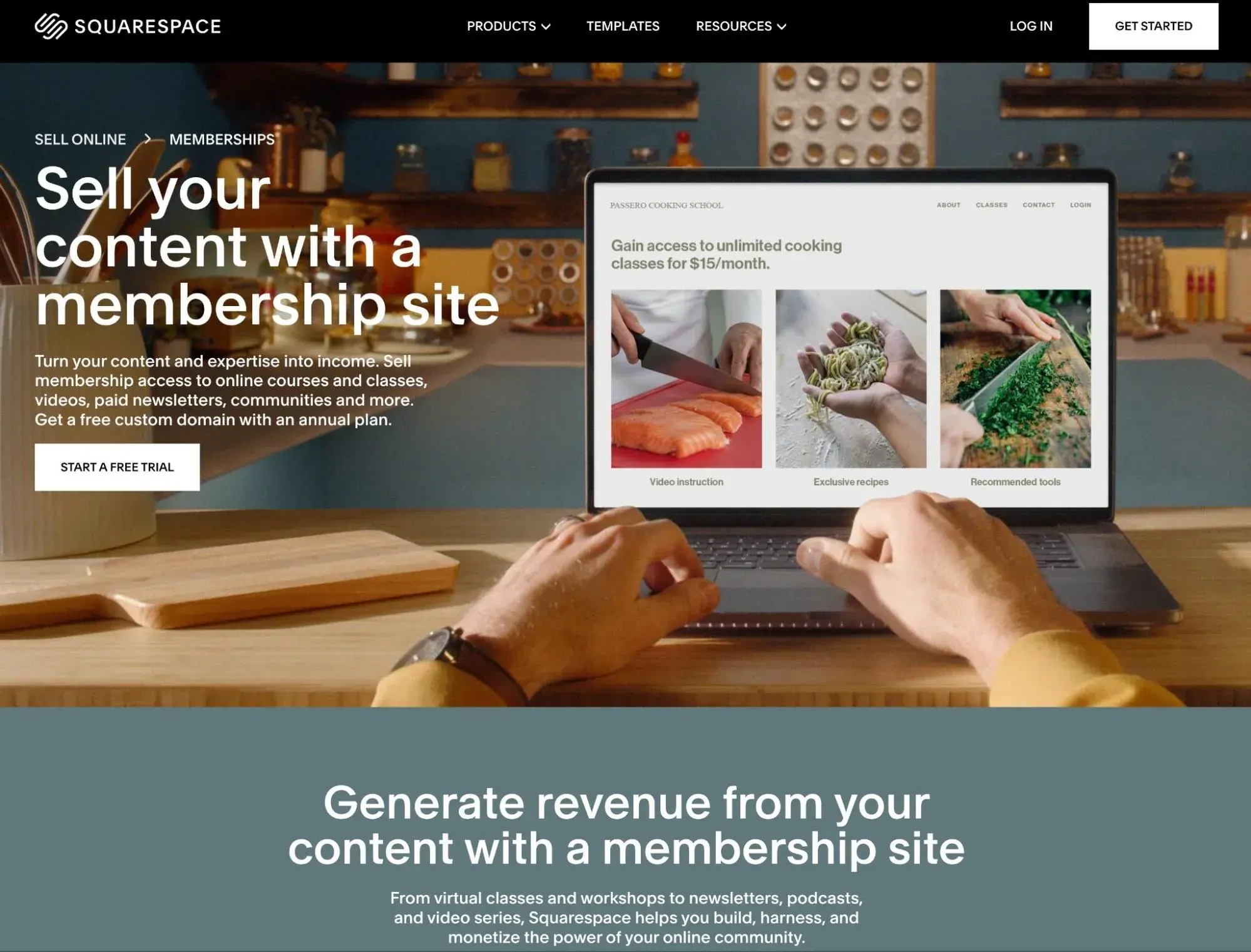
Pricing: Plans start at $25 per month.
Like Wix, Squarespace is another general-purpose website builder that has also added robust support for memberships and subscriptions.
In the past, Squarespace made you use third-party services for membership functionality. But now that Squarespace offers built-in membership support, I think it's one of the top subscription website builder tools out there.
You can restrict access to some/all of the content on your site and then sell access to that content with one or more subscription plans. You can use this to deliver online courses, coaching, and more. Squarespace now even includes an option to create a paid newsletter for your subscribers.
In addition to its membership functionality, I also think that Squarespace has one of the best website building experiences out there. You can access lots of great-looking templates and Squarespace's Fluid Engine lets you tweak every element according to your preferences.
Features:
- Pre-made website templates or use AI website builder.
- Free-form website design experience.
- Unlimited membership levels, including free or paid subscriptions.
- Unlimited subscribers on all plans.
- Members-only content, including online courses and email newsletters.
- Built-in analytics and reporting for your memberships.
- Subscriber cohorts (great for online classes).
- Option to customize member transactional emails.
Pros:
- Completely free-form design tool. I love Squarespace‘s visual website builder because it doesn’t limit you to a pre-set grid like some other tools. Instead, the Fluid Engine lets you place every element exactly where you want it.
- Creative aesthetic. Squarespace has a pretty unique aesthetic that I think makes it especially attractive if you're in creative spaces like photography, graphic design, videography, and so on.
- Email newsletters included. You can create a members-only email newsletter without needing to use a third-party tool, which I think is an advantage over some other subscription website builders.
Cons:
- Added transaction fee on entry level. Squarespace charges a 3-9% added transaction fee for membership plan sales on its entry-level plans. You'll need to choose one of the more expensive plans to get 0% transaction fees.
- Limited extension/integration marketplace. When compared to other website builders like Wix and WordPress, I find Squarespace's collection of extensions and integrations to be somewhat limited.
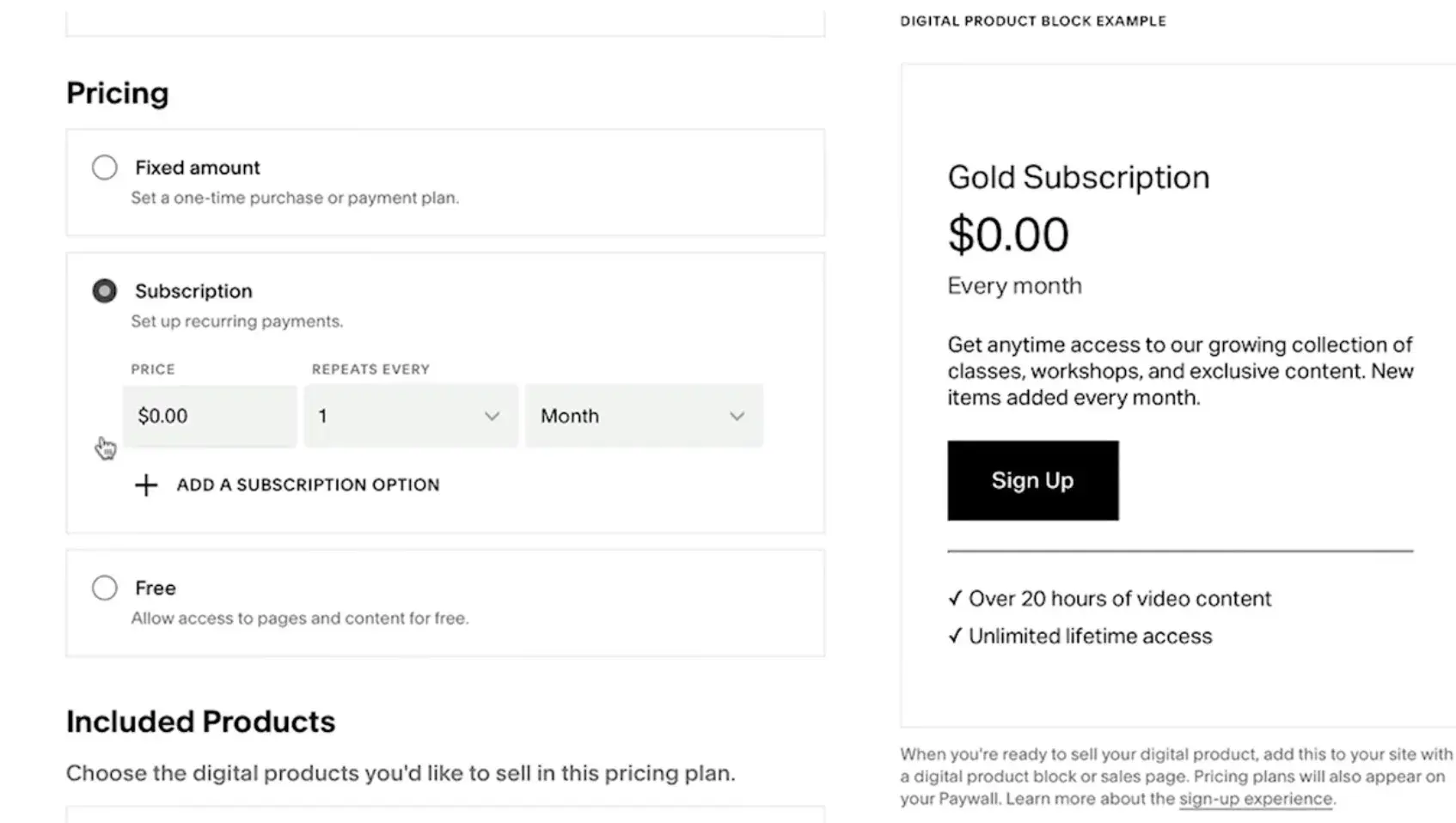
What I love: I‘m a huge fan of Squarespace’s unique aesthetic, which makes it especially suited to creators like photographers, artists, coaches, and so on. While all different types of membership websites can benefit from Squarespace, I think that it's especially suited for membership sites focused on creative areas.
6. Teachable
Best for: Selling online courses to your members.
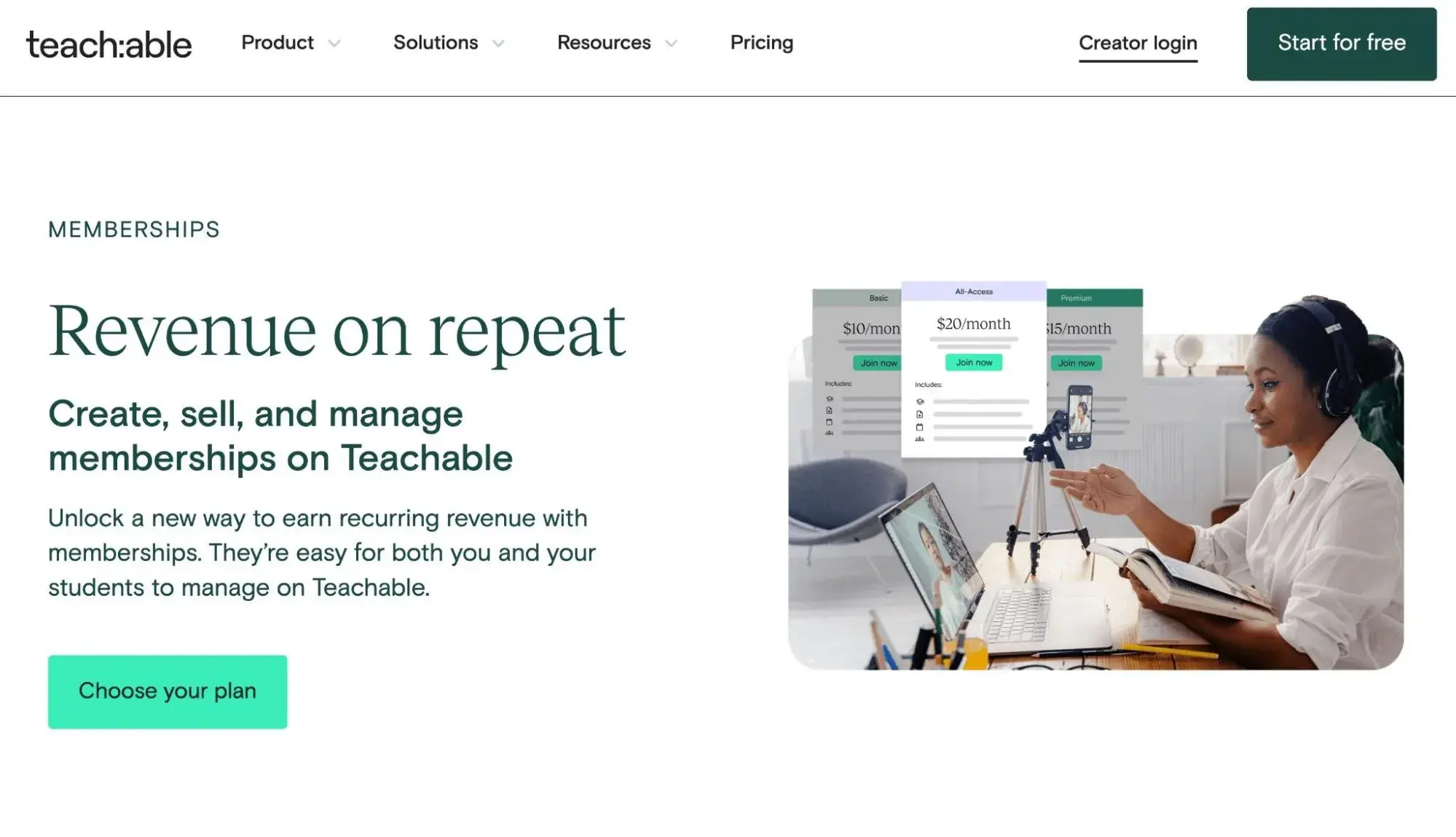
Pricing: Plans start at $39 per month, but you'll need at least the $119 plan if you want to create multiple subscription tiers.
Teachable is one of the best membership website builders designed for educators and course creators. I think it can be a great option if you're specifically looking to create and deliver online courses to your members, but there are probably better options if your goal is to just create a general-purpose membership website.
Teachable is a hosted SaaS tool, which means you don‘t need to mess around with purchasing your own hosting and installing software. In my experience, this can make it especially suited to people who don’t want to deal with any technical issues.
At the same time, Teachable includes all of the features that you need to handle subscription memberships. In addition to selling one-off access to courses, you can also create unlimited membership levels and charge students on a subscription basis,
Essential features:
- Hosted SaaS tool.
- Unlimited membership subscription tiers with monthly or annual billing.
- Built-in payment processing solution, along with the option to use custom payment gateways like Stripe and PayPal.
- Frontend members area so that students can manage their own subscriptions.
- Tools to sell coaching or digital products in addition to courses.
Pros:
- Non-technical and hands-off. Because it's a hosted SaaS tool, Teachable handles all the technical and maintenance aspects for you. This lets you just focus on your membership courses.
- Excellent user experiences. I think Teachable offers a great user experience on both the front end (for your subscribers) and the back end (for you and your team while managing your subscription website).
- Other options beyond courses. While Teachable's primary focus is online courses, it also includes tools for selling digital products and coaching services.
- Marketing tools. Teachable offers some useful marketing tools such as email marketing, upsells, and affiliate marketing. You can also connect Teachable to the free HubSpot CRM to access all of HubSpot's marketing, sales, and service tools.
Cons:
- Cheaper options available in some situations. If you want to create multiple subscription tiers, you might be able to find cheaper tools.
- Added transaction fee on Basic plan. The $39 per month Basic plan adds a 5% transaction fee. You need to move to the $119 per month Pro plan to remove the fee.
- No underlying code access. Because it‘s a hosted SaaS tool, you don’t get as much access to the underlying code as you would with an open-source tool like WordPress. Developers and technical users might not like this.

What I love: I love Teachable‘s focus on empowering creators to launch online learning products, as many other subscription website builders are more focused on general membership websites. In my opinion, it’s one of the best hosted SaaS tools for selling subscription-based online courses.
7. EzyCourse
Best for: Digital creators looking for an all-in-one platform for memberships, courses, and communities.
Pricing: Plans start at $45 per month.
EzyCourse is an all-in-one membership site platform that helps you create any type of membership site with a no-code website builder. You can create site-wide membership tiers, manage a multi-tiered membership system, and add membership upgrade and downgrade options.
Creators can use EzyCourse to create online courses, coaching, communities, memberships, and more. Notably, you will get a branded mobile app where you can offer everything on mobile. This platform makes membership plans more accessible with flexible pricing options including split payments, subscription plans, and donation-based pricing. It also includes built-in email marketing tools, native Zoom integration, and detailed analytics.
Essential features:
- Membership levels with flexible pricing options, including split payments, subscription pricing, donation pricing, and more.
- No-code website builder
- Options to sell digital and physical products, online courses, coaching, and more.
- Built-in email marketing tool
- Community-building features include community tabs and discussion groups.
- Analytics dashboard
Pros:
- Versatile monetization options. You can sell everything from memberships and courses to any digital or physical products.
- Site-Wide Membership. You can turn your site into a Netflix-like membership platform.
- Community features. You can build and manage communities to improve engagement.
- Cheaper options available in some situations. No free plan provided.
Membership Website Examples to Check Out
1. Suffolk Building Society

Suffolk Building Society is designed to help members either save their money by setting up a savings account or buy a home by setting up a mortgage.
This community of “savers and borrowers” has access to many resources. I particularly like the member’s lounge. It includes information about managing an account with Suffolk, their sponsor partners, and ways to get involved with the community.
There’s also a blog that posts the latest news and updates across the society. Here, I found exclusive content and events, including a newsletter and an annual general meeting.
What I Like
Suffolk Building Society offers a mix of public and members-only content. They dedicate a part of the website as a “member’s lounge” to give crucial information about the membership.
I also like that there are multiple ways for visitors to get in touch with their team, including a Contact navigation link and CTA button, social media links, and a telephone number.
2. Startup Empire
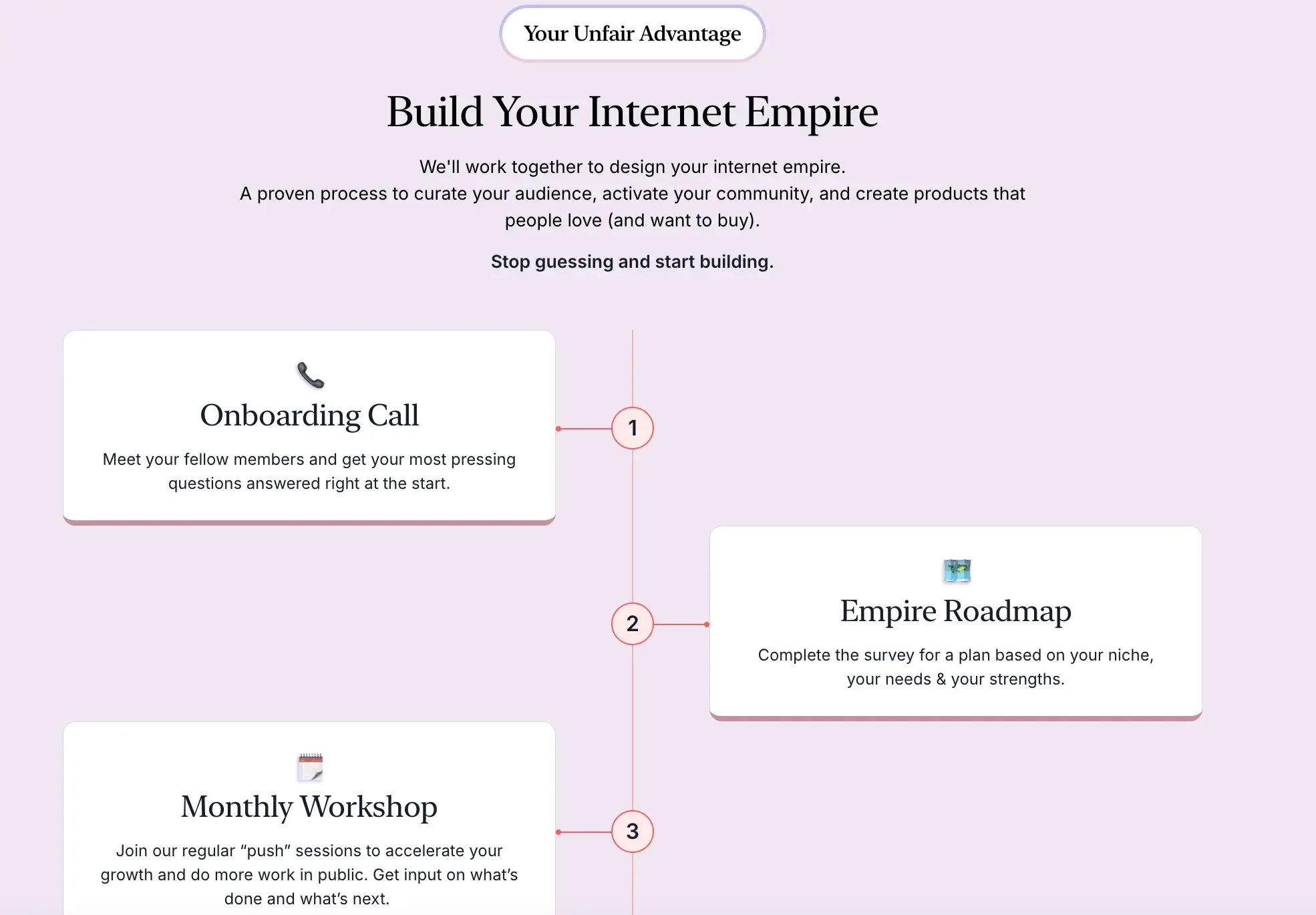
When I first checked out Startup Empire, I was pulled in by the design. The homepage is simple, using informative text and a limited color palette. The look screams “sleek” and “cutting-edge,” two aspirational descriptors for startups.
Startup Empire offers a private membership for entrepreneurs and creators who want to leverage their communities to build their businesses. The membership requires an application. The home page clearly communicates the value of the program — community building, insider tips, and networking opportunities. After the prospect’s interest is piqued, the site then lays out exactly what the application process looks like so users are never in the dark.
What I Like
The homepage teases the courses that are available to members, listing the titles and who the instructors are. Notable teachers also have their faces visible near their course. A big appeal of the membership is who the participant will have access to. The site gets potential members excited to network.
3. Sydney FC
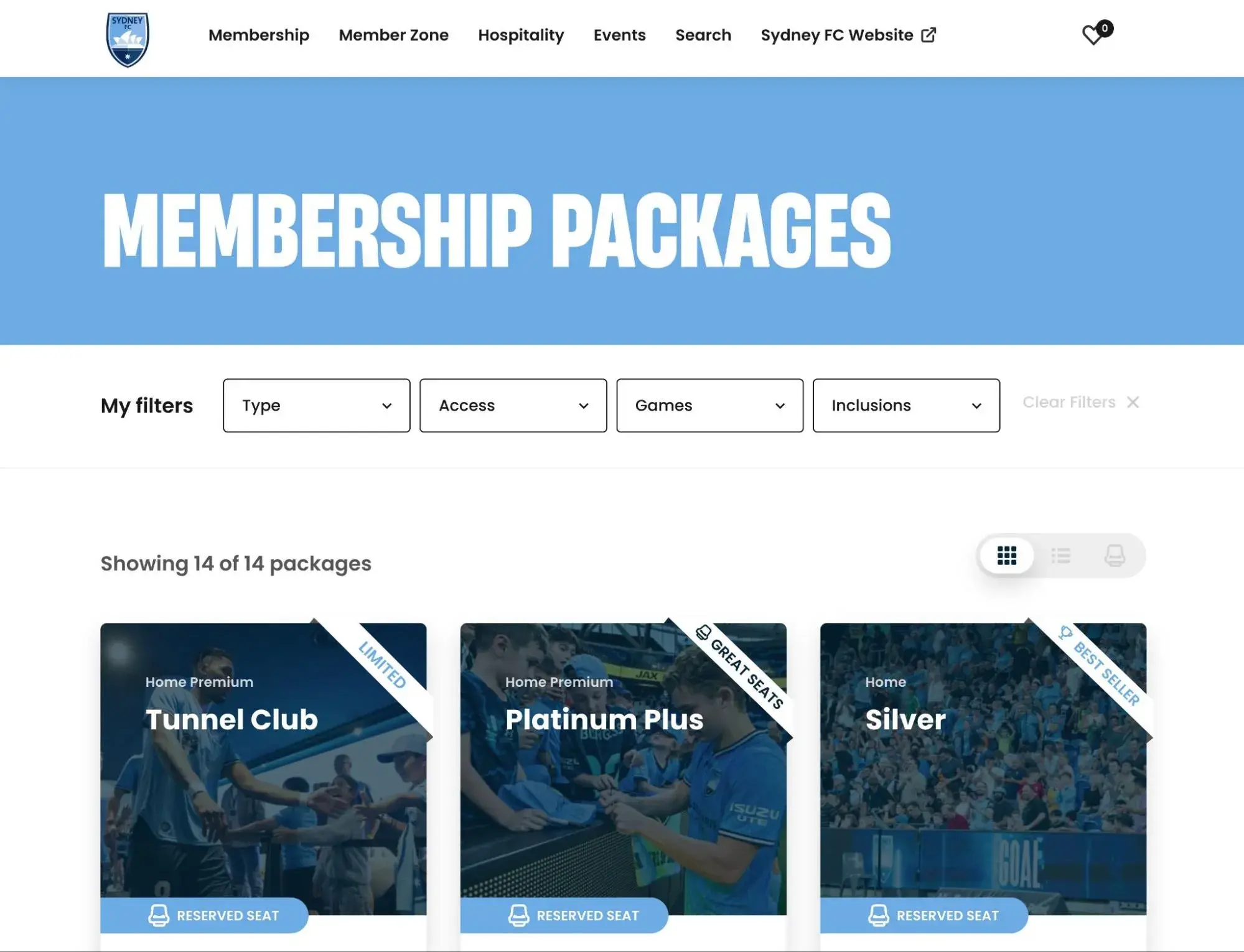
Sydney FC is where visitors can go to find Sydney FC membership packages, hospitality options, and info about the Sydney Football Stadium.
Members and fans alike can find the perfect seats based on preferences, like how close they want to be to the field, their ideal position in terms of the halfway line, goals, and Sun, and who will be part of their group.
Members get first access to tickets and exclusive parts of the stadium, like the inner sanctum, terrace bar, and the cove.
What I Like
I found Sydney FC’s eight membership packages ideal for adults, juniors, and families. The price points cater to different groups of fans, offering something for everyone.
The membership site also offers a personalized form to help visitors find the “perfect” location and membership package. Plus, I was happy to see the FAQ sections tailored to corporate and other membership packages for sharing relevant information.
4. The Nifty Portal

The Nifty Portal functions as a premium membership pass into The Nifty Community, a group of aspiring and successful NFT collectors and creators.
Members get early access to minting, with private investors going first and the public going last. They also get exclusive access to the members-only area of Nifty’s Discord and software, which provides NFT market monitoring, portfolio monitoring, and other (secret) features.
What I Like
At The Nifty Portal, members get access to minting earlier than the public, a members-only area of Nifty’s Discord and other software. Membership also offers other ways for members and non-members to stay informed, such as Discord and YouTube.
I particularly liked the glitch effects and the overall design that make the site feel like a video game.
5. The Vines
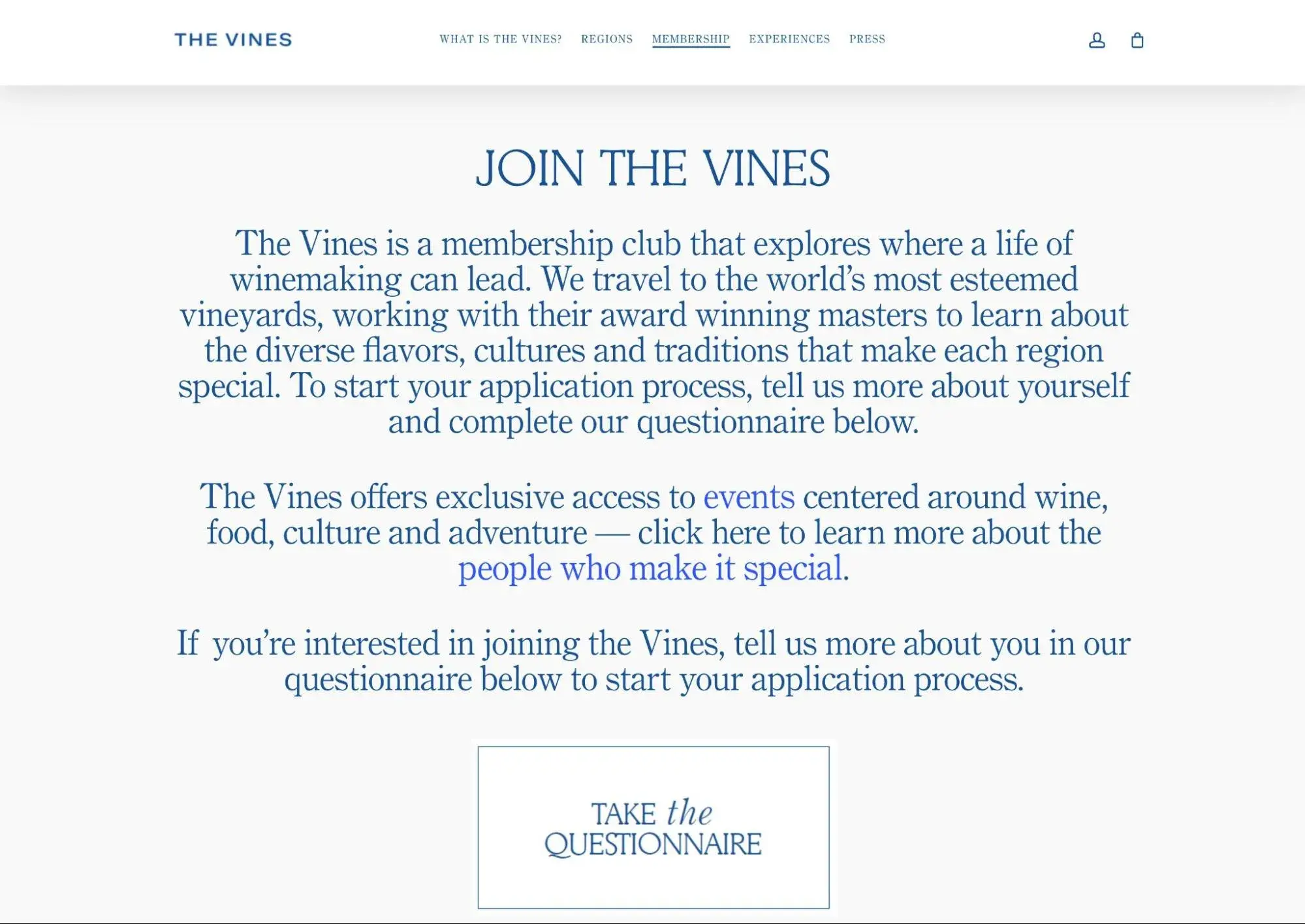
The Vines is a global winemaking membership program. Members choose a winemaking region to learn the craft from some of the greatest winemakers in the world and create their own unique vintages. They also get access to virtual events with chefs, multi-day Blending escapes, and trips to Europe and other parts of the world.
What I Like
The site includes creative descriptions of past events to motivate potential members to join the community. I also liked a glimpse of member profiles so visitors can get to know the community and get some inspiration before filling out the questionnaire.
The video backgrounds on the homepage are equally engaging and showcase what life’s like within the community.
6. Head Wines

Head Wines is the ecommerce site of a boutique Australian winemaker. I can purchase wine by the bottle or set up a subscription.
I can also become a Limestone member of The Stone Cellar wine club simply by signing up for an account and making a purchase. This club is designed to reward its most valued customers for their continuous loyalty with product discounts, access to limited releases, special wines, pre-releases, invitations to member-only experiences, and other exclusive offers.
What I Like
I liked that Head Wines members get access to a login area where discounts, complimentary shipping, and other benefits are automatically applied. The Limestone membership has no minimum spending requirement — a big plus point.
Besides, the brand offers two “premium” membership levels with minimum spend requirements and additional perks.
7. The Daily Stoic

The Daily Stoic is a website that provides valuable insights and teachings from the philosophy of Stoicism on a daily basis. The Daily Stoic members get access to exclusive daily email meditations, a hardcover book of Stoic wisdom, a private community platform, and members-only discounts.
What I Like
I was impressed by the members-only swag as an incentive to sign up. You’ll also find public access to the blog and social media sites to learn more about the website. Plus, membership gives private access to the Facebook group and community.
8. Tom Ross
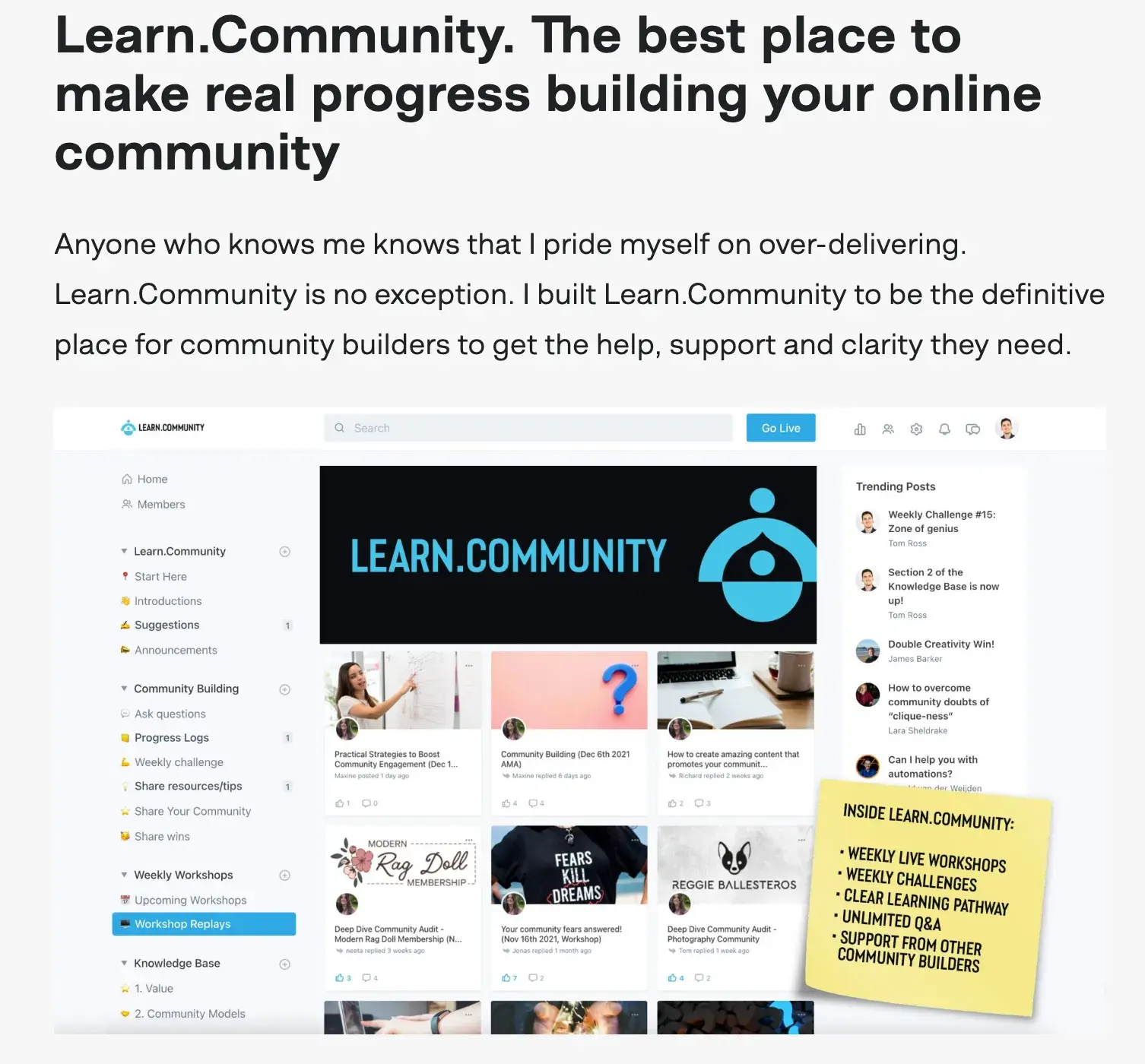
Membership may be just one part of what your site offers. So, how do you pitch a paid community when there are plenty of free resources available? The pitch needs to be immaculate, and Tom Ross gets it right.
Tom Ross’ community page spends time proving the value of membership. Visitors learn exactly what they can get (weekly workshops, forum access, learning pathways, and a library of digital content), so they don’t have to ask, “Is this worth it?” The page ends with testimonials that show value, persuading anyone not yet convinced.
What I Like
There are plenty of pictures of what the community interface will look like. This makes the offering more tangible. I can picture myself learning from the site.
9. Food Blogger Pro

Food Blogger Pro is a platform dedicated to helping food bloggers take their craft to the next level. With a membership to Food Blogger Pro, aspiring and experienced food bloggers gain access to exclusive content and resources that can enhance their skills and grow their online presence.
The platform offers a mix of public and members-only content, providing valuable insights and tips on topics such as recipe development, food photography, monetization strategies, and social media marketing.
What I Like
Food Blogger Pro offers a member's lounge where members can connect with each other — a great way to initiate conversation between members. I was also impressed by their massive repository of 80+ blogging courses with in-depth insights and actionable tips.
Besides, you’ll learn tried-and-test tips and techniques for growing your food blog.
10. GuitarZero2Hero

GuitarZero2Hero is a membership program that aims to transform beginners into skilled guitarists. With its comprehensive lessons and resources, GuitarZero2Hero provides aspiring musicians with the tools they need to progress from zero to hero.
The premium membership of this website grants access to exclusive content designed to help aspiring guitarists grow.
What I Like
This site also offers a member's forum where members can converse and connect with each other, ask questions, and more. Another great benefit of this community is the free access to hundreds of song lessons. Plus, the paid access gives you exclusive lessons beyond the free tier.
You’re All Set to Build Your Membership Website
In my experience, building a subscription membership website is one of the best ways to build lasting, recurring revenue on the internet. With the membership builders on this list, sorting out all the technical details isn't that difficult, either.
Of course, creating the membership content and finding your members will take time and effort. But if you choose one of the tools on this list, I‘m confident that you’ll be ready for success on the technical end.
Get started with one of these tools today, and you'll have your first subscriber in no time.
Editor's note: This post was originally published in April 2024 and has been updated for comprehensiveness.
Content Management System



